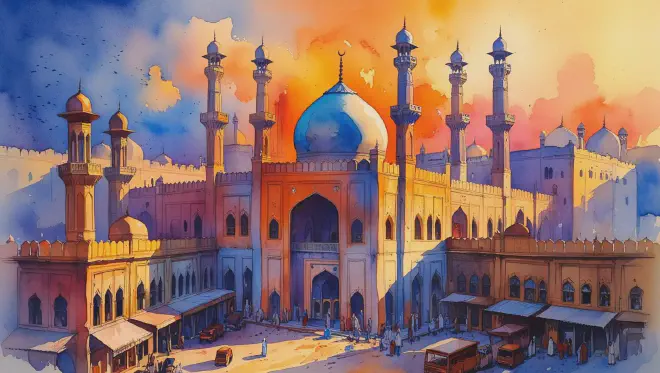Introduction: The City of Poets and Its Historical Melodies
When you speak the name Lahore, thousands of years of history echo within it. Though Pakistan’s second-largest city, Lahore transcends mere urban boundaries. Red sandstone fortress walls that narrate the glory of the Mughal Empire, intricate Islamic architectural decorations, and the vibrant street scenes that pulse with modern life—Lahore is called “the heart of Pakistan,” a cultural and artistic center that has been beloved by poets throughout the ages.
Situated along the banks of the Ravi River, a tributary of the Indus, this city has long flourished as a vital crossroads of the Silk Road. Hinduism, Buddhism, Islam, and Sikhism have intersected here, with each culture layering upon the others to create a unique and captivating character. Walking through the streets, one can almost catch the lingering fragrance of the rose gardens once cherished by Mughal emperors Akbar and Shah Jahan.
From winter’s end to early spring, Lahore basks in gentle sunlight that warms the dry earth, while marigolds bloom brilliantly on street corners. Choosing this season, I decided to open the door to this poetic city, traveling alone into its embrace.

Day 1: Modern Rhythms Echo Within Ancient Walls
The moment I stepped off the plane at Allama Iqbal International Airport, Lahore’s dry air enveloped my skin. The landscape visible through the taxi windows on the way to the city center was greener than I had imagined, with eucalyptus trees lining the streets against the blue sky. Ali Saheb, my driver, spoke fluent English as he shared the city’s history, first guiding me to the heart of the old city.
In the morning sunlight, I first made my way to Lahore Fort. Built in 1566 by Mughal Emperor Akbar, this fortress overwhelms visitors with its beautiful contrast of red sandstone and white marble. Tracing my fingers along the delicate geometric patterns carved into the fortress walls, I could feel the breath of craftsmen from centuries past. In the Sheesh Mahal (Palace of Mirrors), countless small mirrors caught the morning light, twinkling like a starry sky.
Leaving the fort, the magnificent Badshahi Mosque immediately came into view. Completed in 1673, this grand mosque boasts the capacity to accommodate 100,000 worshippers at once. Removing my shoes and stepping into the courtyard, the red sandstone felt warm beneath my bare feet, while the sound of water from the central fountain brought peace to my heart. As afternoon prayer time approached, the muezzin’s beautiful call to prayer resonated through the sky, enveloping the entire city in silence.
For lunch, I found a small restaurant in the maze-like alleys of the old city. “Chole Bhature”—a combination of spiced chickpea curry and fried bread—had a more complex and profound flavor than I had anticipated. The elderly shop owner said “Arigato” in broken Japanese while offering me additional chai for free. The aroma of the sweet, milk-stewed tea enriched the foreign afternoon.
In the afternoon, I walked through Anarkali Bazaar, the old city’s commercial district. Colorful silk and cotton fabrics, hand-woven carpets, and brass handicrafts filled every available space. When I was allowed to observe a craftsman hand-embroidering a Kashmiri shawl, I was breathless at the delicate technique. The concentration and love poured into each stitch created beautiful floral patterns on the fabric.
In the evening, I walked along the banks of the Ravi River. The setting sun shimmered on the water’s surface, while Quranic recitation drifted from the distance. Watching local families enjoying picnics, I truly felt that this was indeed a place where people lived their daily lives.
Returning to my heritage hotel, jasmine flowers bloomed in the courtyard, and the sound of fountain water soothed the day’s fatigue. For dinner at the hotel restaurant, I ordered “Biryani.” The aroma of saffron and spices that had soaked into the basmati rice filled my mouth, while the tender, slow-cooked mutton provided an exquisite flavor. The dessert, “Ras Malai,” featured soft cheese balls floating in sweet syrup—truly a taste of heaven.
That night, opening my window, I could hear the sound of tabla drums in the distance. Perhaps it was the sound of a mushaira (poetry recitation) being held somewhere. Lahore’s night deepened, wrapped in poetry and music.
Day 2: Eternal Beauty Fragrant in the Gardens
I awoke to birdsong as morning light streamed into the hotel courtyard. Today would be devoted to experiencing Lahore’s renowned garden culture. After a light breakfast of paratha (layered flatbread) and omelet, I first headed to Shalimar Gardens.
Created in 1641 by Mughal Emperor Shah Jahan, Shalimar Gardens truly deserves the description “earthly paradise.” The garden is divided into three terraced levels, each possessing its own distinct beauty. In the upper terrace, “Farah Bakhsh” (the Joy-Bestowing Garden), I walked along white marble water channels while imagining emperors from centuries past composing poetry and enjoying music here.
In the middle terrace’s water palace, I was overwhelmed by the sight of 41 fountains simultaneously shooting water into the air. Water droplets sparkled in the morning sun, creating tiny rainbows like scattered jewels. Rafiq Saheb, the gardener, explained the intricate workings of the water channels. The Mughal-era technology that circulated water using gravity alone was astounding even by modern standards.
In the lower garden, colorful flowers formed geometric patterns. The mingled fragrances of roses, jasmine, and chamomile filled the air while butterflies danced gracefully. Sitting on a bench overlooking the garden, I was enveloped in a silence that seemed to stop the flow of time.
In the afternoon, I visited the Lahore Museum, which offered a contrasting atmosphere. This museum, whose first director was Kipling’s father, is renowned as a treasure house of Gandhara art. The Buddhist statues from the 2nd to 5th centuries CE possessed a unique beauty that fused Greco-Roman and Indian cultures. Particularly impressive was a Bodhisattva statue with an expression of compassion. Its gentle smile seemed to speak to people’s hearts across religions and ages.
The museum’s collection of Mughal-era miniature paintings was also magnificent, with court life and hunting scenes depicted in precise detail. Small canvases adorned with gold leaf and vivid colors contained almost photographic realism.
For lunch, I visited “Koza Garden Restaurant” near the museum to savor traditional Punjabi cuisine. “Sarson da Saag” (mustard greens curry) paired with “Makki di Roti” (cornmeal bread) offered a simple yet profound flavor. Tearing the hot, butter-laden roti by hand and dipping it into the rich green curry, I felt the weight of flavors that had been beloved in this land for generations.
In the late afternoon, I visited the shrine of Hazrat Ali Hajveri (Data Darbar). This 11th-century Sufi saint’s tomb attracts many pilgrims from within Pakistan and beyond. In front of the shrine, qawwali (Sufi music) voices resonated as people offered their prayers. The atmosphere was warm and welcoming, embracing all people beyond religious boundaries.
In the evening, I watched the sunset from Hazuri Bagh (the garden in front of Lahore Fort). Everyday scenes of locals playing cricket and families picnicking gave this historic place an approachable quality. Sitting on the grass and looking up at the orange-tinted sky, I felt history and present naturally melding together.
For dinner, I went to “Phoot Shop,” an old restaurant in the old city, and ordered their specialty “Paye” (braised cattle or sheep trotters). The collagen-rich soup, slowly simmered, was nourishing and warmed me to my core. Eating among local people, tearing naan by hand and scooping up the soup, was truly glimpsing a part of life-rooted culture.
That night, I gazed at Lahore’s cityscape from the hotel’s rooftop terrace. Mosque minarets were illuminated, and the sound of people chatting drifted from the narrow alleys of the old city. Under the star-filled sky, feeling the deep cultural layers this city possessed, the second night quietly deepened.
Day 3: The Poet’s Voice Echoes in the Morning of Farewell
My final morning began with a visit to the mausoleum of Allama Iqbal, the great poet born in Lahore. Located across from Badshahi Mosque, this red sandstone mausoleum is simple yet dignified. Iqbal’s poetry, from the man called “the Jewel of the East,” is beautifully inscribed in Urdu on the mausoleum walls. Listening to local students reciting his poetry, I felt anew the universality of the power of words.
Leaving the mausoleum, I had my final breakfast at a small nearby café called “Chai Dukaan.” Tea drunk from an earthenware cup had a completely different earthy aroma than plastic or ceramic versions, evoking somehow nostalgic feelings. The shopkeeper’s son, a young boy, spoke to me in broken English about school. His eyes sparkled with hope for the future.
I spent the remaining morning walking through the old city once more. In the narrow alleys continuing from Delhi Gate, a metalworker was carving intricate patterns into a brass vase. Watching his concentrated expression and hand movements, I could feel the craft and spirit of artisans unchanged for hundreds of years. In the neighboring workshop, a wood carver was etching delicate geometric patterns into walnut wood. Admiring the beauty of the finished work, craftsman Aslam Saheb proudly told me, “This is a technique I inherited from my grandfather.”
Before heading to the airport, I went for lunch to try “Lahori Fish,” a Lahore specialty. Freshwater fish caught in the Ravi River, marinated in spices and baked in a tandoor (clay oven), was crispy outside and juicy inside—absolutely exquisite. It was a memorable flavor befitting a final meal.
In the taxi heading to the airport, driver Ali Saheb asked, “Did you enjoy Lahore?” Looking at the scenery flowing past the window, I felt everything I had experienced over these three days resonating within me like a beautiful melody. Red sandstone fortress walls, butterflies dancing in gardens, craftsmen’s hands, poets’ words, and above all, people’s warm smiles—all of these formed the essence of the city called Lahore.
While waiting at the airport departure gate, I recorded my travel memories in my notebook. Just as ink soaked into paper, my Lahore experiences were deeply etched into my heart. Bidding farewell to Lahore’s cityscape visible through the window, a desire to return someday welled up in my chest.
Conclusion: What Was Certainly Felt Though Imagined
This three-day journey was a product of imagination, never having actually set foot there. However, the experience of walking Lahore’s street corners in my heart, conversing with people, touching historical monuments, and tasting traditional cuisine was surprisingly vivid and real.
Though imagined, the reason it felt so genuinely present must be due to the mysterious power of human imagination and memory. Landscapes, sounds, aromas, and tastes described in words become etched in the heart just like actual experiences, connecting with emotions to become living memories. The rich cultural background that the city of Lahore possesses, and the warmth of the lives of its people, certainly comes through even via imagination.
Travel does not necessarily mean only physical movement. Touching different cultures in one’s heart, reflecting on history, and letting imagination wander through people’s lives—this too may be one form of travel. Through this imaginary journey, my understanding and affection for the country of Pakistan and the city of Lahore certainly deepened.
If the opportunity arises, I would like to actually set foot on Lahore’s soil next time and truly encounter the landscapes and people I met in this imaginary travel. How this imagined memory would resonate with reality would surely be another fascinating experience.

